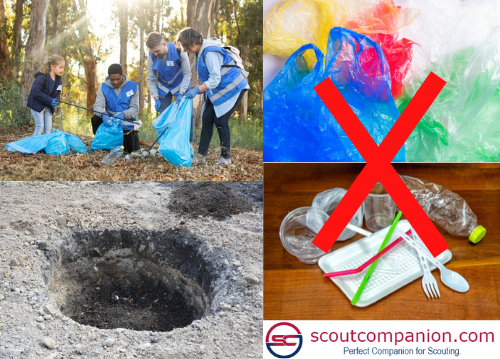Environmental Stewardship in Scouting has always been a cornerstone of Scouting. Whether it’s cleaning up a local park, organizing tree-planting events, or simply learning to respect wildlife during a hike, the Environmental Stewardship in Scouting always instills a sense of responsibility for the natural world. The promise the Scouts make in their heart is “to leave the world a better place than you found it”.

Table of Contents
Introduction
Environmental stewardship in Scouting is an integral part of Scouting, a global movement dedicated for developing responsible citizens who can voluntarily contribute to the well-being of society. This pledge reflects the importance of preserving nature and ensuring sustainable use of available natural resources. Scouting organizations all over the world have adopted frameworks to teach outdoor ethics and sustainability, with the Leave No Trace (LNT) principles standing out as one of the most effective and comprehensive approaches.
The Leave No Trace principles, developed by the Leave No Trace Center for Outdoor Ethics, provide actionable guidelines for minimizing the environmental impact caused by human activities. For Scouts, these principles represent more than rules; they are a way of life, instilling values of respect, care, and responsibility toward the environment.
This article explores the essence of environmental stewardship in Scouting, the origins of Leave No Trace principles, their application in outdoor activities, and also discusses how scouts can protect our natural world and the importance of respecting outdoor spaces, challenges in implementation, and the broader impact on global conservation efforts. To learn more about Environmental Stewardship in Scouting and Leave No Trace Principles, you can explore the Boy Scouts of America Official Site.
Understanding Environmental Stewardship in Scouting

Environmental Stewardship in Scouting emphasizes the interconnections of humans and mother nature. It calls for thoughtful actions that ensure the health and sustainability of ecosystems. For Scouts, environmental stewardship is a way to develop a deep respect for the natural world, encouraging them to care for the environment through deliberate choices and actions.
The Scout Law, which calls the Scouts to be “helpful,” “thrifty,” and “reverent” aligns closely with the principles of environmental stewardship in scouting.
For example:
- Helpful: Scouts participate in natural and environment conservation projects, assisting in the restoration of damaged ecosystems, water resources, and forest areas.
- Thrifty: They practice sustainable living by using available resources wisely and avoiding wasting the non-renewable resources.
- Reverent: They honor the beauty and sanctity of mother nature, recognizing it as a source of inspiration and birth of new life.
Incorporating Environmental Stewardship in Scouting programs allows young people to develop practical skills while fostering a lifelong commitment to sustainability. Outdoor activities like camping, hiking, and trekking provide opportunities to Scouts to engage with nature and understand the importance of protecting it and how it protects us.
The Origin and Evolution of Leave No Trace Principles
The Leave No Trace principles, followed by the Environmental Stewardship in Scouting originated in the mid-20th century, in the period when outdoor recreation in the United States became popular. As more people stepped into wilderness areas, the negative impact of human activities became evident: trails were destroyed, campsites expanded, and natural habitats suffered irreversible damage.
Government agencies such as the U.S. Forest Service and the Bureau of Land Management began promoting minimal-impact camping techniques in the 1960s to address these concerns. By the 1990s, these ideas evolved into the formal Leave No Trace program, established by the Leave No Trace Center for Outdoor Ethics. The program introduced the seven principles that would serve as a universal guide for outdoor explorers who follows Environmental Stewardship in Scouting principle.
Scouting organizations were quick to adopt these principles due to their alignment with Scouting values. The Boy Scouts of America, Scouts Canada, and other groups worldwide integrated Leave No Trace into their curricula, using it to teach young people how to enjoy nature responsibly while minimizing their ecological footprint.
The Seven Principles of Leave No Trace

The Leave No Trace principles are a structured yet adaptable set of guidelines that apply to diverse environments, from thick forests to coastal beaches. Each principle promotes thoughtful behavior that reduces human impact on the natural environment.
The following are the seven principles of Leave No Trace:
- Plan ahead and prepare
- Travel and camp on durable surfaces
- Dispose of waste properly
- Leave what you find
- Minimize campfire impact
- Respect wildlife
- Be considerate of other visitors
1. Plan Ahead and Prepare
Effective planning is the cornerstone of responsible outdoor activity. Scouts are encouraged to take the time to research their destination, anticipate possible challenges, and prepare accordingly. By considering factors such as weather, terrain, and regulations, Scouts can ensure both their safety and the protection of the environment. Proper planning allows for minimal environmental impact and promotes sustainable outdoor practices.
The Environmental Stewardship in Scouting points out the importance of proper planning through the following example:
- A Scout troop preparing for a winter hike might study weather forecasts to anticipate changes in conditions, pack appropriate gear for extreme cold, and familiarize themselves with emergency protocols to respond to challenging circumstances.
- Being prepared not only ensures the safety of the group but also helps reduce the need for excessive resource consumption, such as fuel or shelter materials that could potentially harm the environment.
- By researching local regulations, Scouts learn the importance of respecting rules such as fire restrictions or seasonal closures. These rules often exist to protect fragile ecosystems during certain times of the year when they are most vulnerable to human impact.
Planning ahead also helps Scouts avoid common pitfalls like wandering off-trail, which can lead to soil erosion, habitat destruction, or trampling sensitive plant life. Thoughtful preparation also includes packing out all waste, ensuring that the landscape remains as clean as it was before the Scout group arrived.
2. Travel and Camp on Durable Surfaces

Protecting fragile ecosystems begins with thoughtful choices about where we walk, rest, and camp. Scouts are taught to stick to established trails and campsites to minimize their impact on the environment. Durable surfaces like rock, gravel, or compacted soil can handle repeated use without significant damage, while sensitive areas like wetlands, grassy meadows, or fragile unpolluted vegetation are easily disturbed and may take decades to recover.
The Environmental Stewardship in Scouting points out the importance of durable surfaces through the following example:
- During a high-adventure camping trip, Scouts might deliberately choose an existing, well-used campsite instead of creating a new one in an unpolluted location. This choice reduces harm to undisturbed areas while preserving the natural beauty for future visitors.
- Similarly, when hiking, Scouts are reminded to stay on marked trails, even if the trail is muddy or inconvenient. Leaving the path to find shortcuts might seem harmless, but it can contribute to soil erosion, disrupt plant growth, and damage wildlife habitats.
By following Environmental Stewardship in Scouting principle, Scouts not only preserve natural landscapes but also set an example for others to respect the wilderness. These small actions collectively ensure that our shared outdoor spaces remain beautiful and accessible for generations to come.
3. Dispose of Waste Properly

The simple mantra “pack it in, pack it out” lies at the core of responsible outdoor ethics. It reminds Scouts that everything brought into nature must also be taken out—whether it’s trash, leftover food, or any other type of waste. Proper disposal helps prevent pollution, safeguards wildlife, and preserves the beauty of natural spaces for others to enjoy. Leaving an area cleaner than you found it is a fundamental practice that shows respect for the environment.
The following are the Practical approaches that Environmental Stewardship in Scouting to waste management:
- Using reusable containers to minimize reliance on single-use plastics, which often end up polluting ecosystems.
- Digging small cat holes—6-8 inches deep and at least 200 feet from water sources—for human waste, and packing out hygiene products like toilet paper to ensure nothing unnatural is left behind.
- Avoiding the use of non-biodegradable materials that can linger in the environment for years, harming wildlife or disrupting habitats.
For example, a Scout troop paddling through a remote waterway might carry a portable trash bag to collect both their own waste and any litter they find. Before departing, they carefully scan the campsite, ensuring not a single piece of trash remains. These simple habits instill a sense of responsibility and demonstrate that small actions, when multiplied, can make a significant difference in protecting the wilderness.
4. Leave What You Find

The principle of “Leave What You Find” in Environmental Stewardship in Scouting emphasizes the importance of preserving the natural and cultural integrity of outdoor spaces. Scouts are encouraged to appreciate the beauty and significance of nature without altering or damaging it. By leaving things as they are, they help ensure that future visitors can experience the same sense of wonder and connection to the environment. Respecting both natural formations and historical artifacts is an essential part of this practice.
The Environmental Stewardship in Scouting suggests the following Key practices:
- Avoiding the temptation to collect rocks, plants, or artifacts as souvenirs, recognizing that even small removals can disrupt ecosystems.
- Leaving historical structures, such as old cabins, ruins, or tools, untouched so that they remain intact for future generations to appreciate and learn from.
- Refraining from carving into trees, painting on rocks, or engaging in any activity that permanently alters natural or cultural landmarks.
For instance, while hiking in a national park, Scouts might come across a rare flower or an unusual rock formation. Instead of picking the flower or taking the rock, they could capture its beauty in a photograph, allowing them to remember the experience without disturbing the environment. By practicing “Leave What You Find,” Scouts contribute to the conservation of nature’s fragile balance and help preserve its timeless allure for others.
“Leave What You Find” in Environmental Stewardship in Scouting teaches respect, restraint, and mindfulness—values that extend far beyond the trail. Every action taken (or not taken) becomes a building block in protecting the natural world for all to enjoy.
5. Minimize Campfire Impact

Campfires hold a special place in outdoor traditions, bringing people together for warmth, cooking, and storytelling. However, without proper care, they can cause lasting harm to the environment. Scouts are taught to balance the joy of a campfire with responsible practices to ensure minimal impact. In many cases, lightweight stoves and lanterns are encouraged as alternatives for cooking and light, reducing the need for fires altogether.
Environmental Stewardship in Scouting suggests the following practices to protect the environment during campfires:
- Using established fire rings or fire pans to concentrate impact and prevent soil damage or scarring.
- Collecting only dead and fallen wood that is no larger than a Scout’s wrist, avoiding live trees or branches that are vital to the ecosystem.
- Keeping campfires small, manageable, and within control to limit resource use and reduce the risk of accidental wildfires.
- Fully extinguishing fires by dousing them with water, stirring the ashes, and scattering cool remains, leaving no trace of their presence.
For instance, during a weekend camping trip, Scouts might build a modest fire in a designated fire ring to cook a meal. They carefully monitor it, ensuring it doesn’t grow unnecessarily large, and extinguish it thoroughly before leaving. By practicing these methods, Scouts not only reduce the environmental impact but also demonstrate respect for the natural world and the safety of those who share it.
This principle from Environmental Stewardship in Scouting teaches mindfulness and responsibility, reminding Scouts that the privilege of enjoying nature comes with the duty to protect it. A well-managed fire allows the tradition to continue without sacrificing the health of the wilderness for future generations.
6. Respect Wildlife

Respecting wildlife is a cornerstone of outdoor ethics, reminding Scouts to be mindful of the creatures that call nature home. Observing animals from a safe distance allows Scouts to appreciate their beauty and behavior without causing harm or disruption. Interfering with wildlife—such as feeding animals or encroaching on their space—can have unintended consequences, altering their natural habits and making them overly reliant on humans for food, which can lead to dangerous encounters or health issues.
Practical measures to be followed while respecting wildlife as per the Environmental Stewardship in Scouting Principle includes:
- Storing food securely in bear-proof containers or hanging it in trees to prevent animals from accessing human supplies, which could lead to dependency or conflict.
- Keeping noise levels low and avoiding sudden movements that might frighten or stress animals, especially in habitats where they are already vulnerable.
- Ensuring that pets are leashed and under control to prevent them from chasing or injuring wildlife or disturbing nesting areas.
For instance, a group of Scouts camping in a forest might spot a family of deer grazing nearby. Instead of approaching for a closer look, they quietly observe from a distance, allowing the animals to go about their day without feeling threatened or disturbed. Such moments teach Scouts to value nature’s tranquility while fostering a deeper respect for the balance of ecosystems.
By practicing these respectful behaviors from the principles of Environmental Stewardship in Scouting points out the importance of durable surfaces through the following example:, Scouts not only protect wildlife but also contribute to preserving the harmony of the natural world. The Environmental Stewardship in Scouting reinforces the understanding that humans are visitors in the wild and must act as stewards, ensuring that wildlife can thrive undisturbed for generations to come.
7. Be Considerate of Other Visitors
Outdoor spaces are for everyone, and fostering a positive experience for all is an essential part of responsible outdoor ethics. Scouts are encouraged to remember that they share these spaces with others, which means being mindful of their behavior and its impact on other visitors. Simple acts of courtesy—such as keeping noise levels down, yielding to others on trails, and leaving campsites clean—go a long way in ensuring that everyone can enjoy the serenity and beauty of nature.
The Environmental Stewardship in Scouting explains the importance of being considerate through the following examples:
- Keeping group sizes manageable to prevent overcrowding and minimize the impact on trails, campsites, and surrounding wildlife.
- Setting up camp at a distance from high-traffic areas to preserve the solitude and natural experience that many visitors seek.
- Practicing patience and kindness, such as stepping aside for slower hikers or offering help to those who may need assistance on the trail.
For instance, a Scout group hiking through a popular national park might pause at trail junctions to let other visitors pass, ensuring the flow of movement remains smooth and courteous. Similarly, they would avoid loud conversations or music, preserving the peace and quiet that many outdoor enthusiasts cherish.
By prioritizing respect for others, Scouts not only create a welcoming environment but also set a positive example for all outdoor visitors. This principle of Environment Stewardship in Scouting helps cultivate a sense of community and shared responsibility, reminding everyone that enjoying nature is a privilege that requires mutual consideration. When everyone practices kindness and respect, outdoor spaces become more enjoyable and meaningful for all who visit.
Challenges and Opportunities
While Leave No Trace principles offer a clear framework, implementing them consistently can be challenging. Common obstacles include:
- Lack of Awareness: Many outdoor enthusiasts remain unfamiliar with Leave No Trace principles, leading to unintentional environmental harm.
- Overcrowding: Popular destinations often experience heavy traffic, making it difficult to mitigate impacts.
- Resource Limitations: In some areas, inadequate funding for trail maintenance or education programs hinders effective stewardship.
Scouting organizations can address these challenges by:
- Expanding outreach efforts to educate the public about Leave No Trace.
- Partnering with schools, parks, and environmental groups to promote outdoor ethics.
- Advocating for policies that prioritize conservation and sustainable recreation.
The Global Impact of Leave No Trace in Scouting
By adopting Leave No Trace principles, Scouts contribute to a global movement for sustainability and environmental preservation. Their actions ripple outward, inspiring communities, shaping conservation efforts, and even influencing policies aimed at protecting the planet. Scouting’s emphasis on responsible outdoor practices fosters a culture of care that transcends borders and unites people in the common goal of preserving nature.

The global impact of Leave No Trace in Environmental Stewardship in Scouting includes:
- Reforestation Projects: Scouts in Indonesia have planted thousands of mangrove trees to combat coastal erosion and restore critical habitats.
- Waterway Cleanups: Scout groups in Europe frequently organize river-cleaning initiatives, removing tons of debris and improving water quality.
- Advocacy Campaigns: Scouts in Kenya have played a pivotal role in advocating for legislation to ban single-use plastics, fostering a culture of sustainability within their communities.
These initiatives showcase the transformative power of Leave No Trace principles. Scouts demonstrate that even small, consistent actions can lead to significant change, inspiring others to join in the effort to protect the planet. By living out these values, Scouts embody the global mission of environmental stewardship and prove that a collective commitment to conservation can create a better, healthier world.
Conclusion
Environmental Stewardship in Scouting Principles lies at the heart of each scouts, teaching Scouts to care for the natural world through thoughtful actions. The Leave No Trace principles provide a practical framework for minimizing environmental impact while enjoying the outdoors responsibly. By learning to plan carefully, respect wildlife, and tread lightly, Scouts embrace a philosophy of sustainability that extends far beyond their adventures. These Environmental Stewardship in Scouting principles foster a deep respect for nature, reminding Scouts that even small actions can make a lasting difference. By adopting these practices, they contribute to preserving the beauty and health of the environment for future generations, fulfilling Scouting’s mission to leave the world a better place than they found it.


